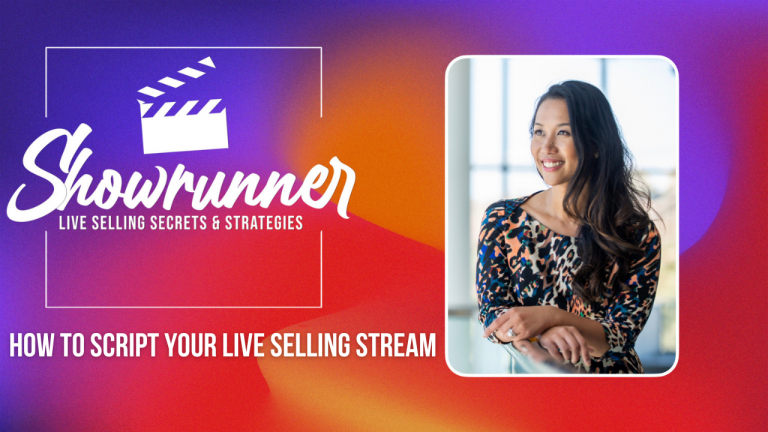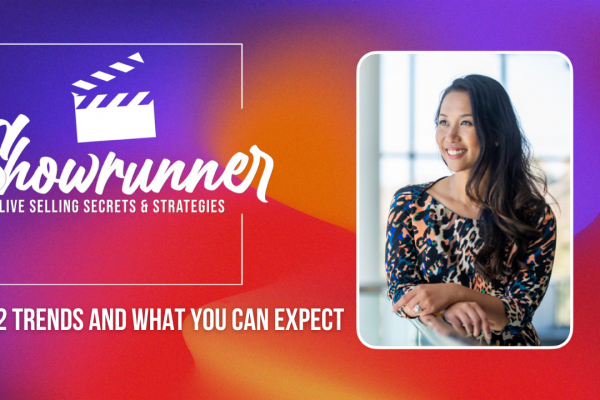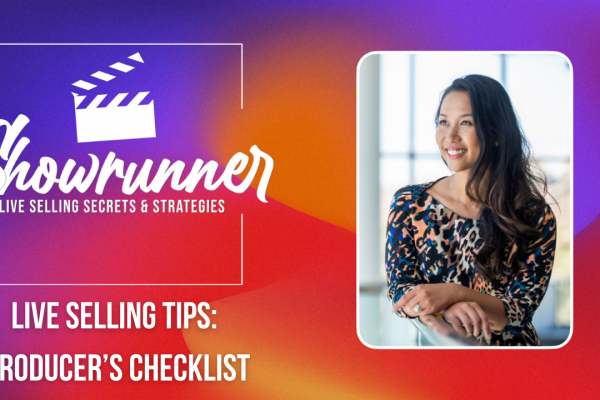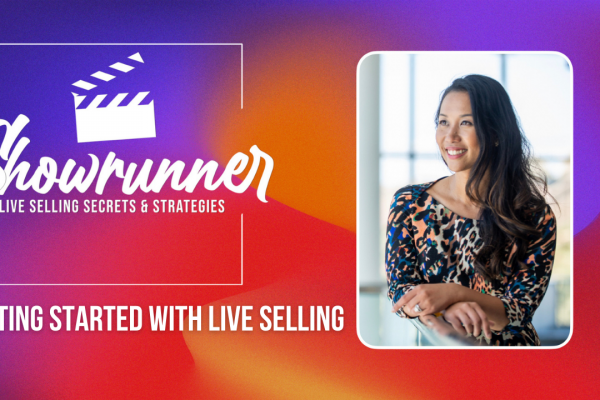Stories excite and stir people’s emotions. Facts and figures don’t. In this post, we’re going to show you how you can develop a live selling script that captivates your audience and motivates the masses to buy. This post is all about how to script your live selling stream.
In this post, we’re going to discuss
- Why you should pay attention to how the live selling platforms look
- Audience learning styles
- How to structure your video script
- The Video Script Maker
- Storytelling
Watch the full episode
On this season of Showrunner, we’re jumping into the world of live selling. Blending entertainment with instant checkouts, live commerce offers retailers, brands, and content creators a new channel to reach and engage audiences. Live shopping has opened doors for on-camera talent, influencers, and even remote live video producers. If you’re not already offering remote live video production to e-commerce clients, NOW is the time to get started.
Pay Attention to How the Live Selling Platforms Look
As you’re thinking about how to script your live selling stream, you should start with the platform itself. What does it look like? What elements are part of each platform? Do you need to move anything around in your script?
When we were chatting about live selling storyboards, I reminded you that it was important to pay attention to where things are. Where does the logo go? How about the viewer count? And the comments? Knowing what the user interface looks like is going to be hugely important during the planning stage of live selling.
That’s going to be really helpful for you as you’re working with your client. When you’re working with the talent, it’s a great way to let your talent know – hey, point down here. That’s where the product is going to be.

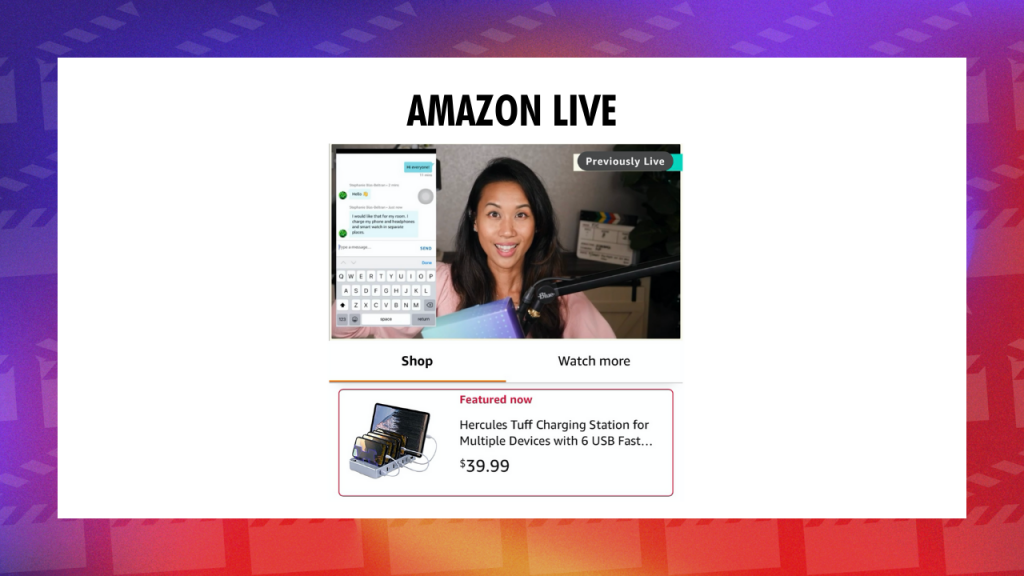
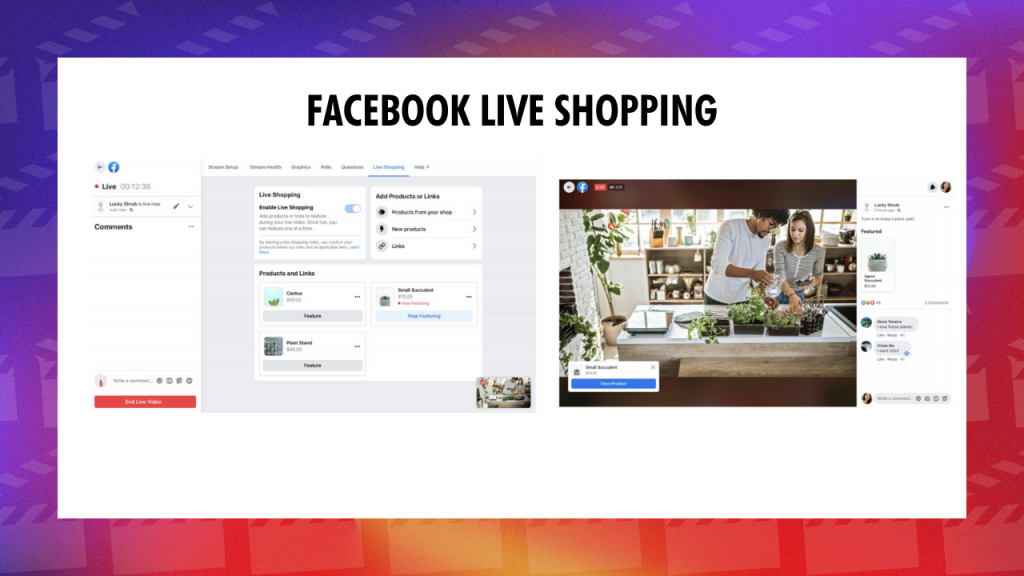
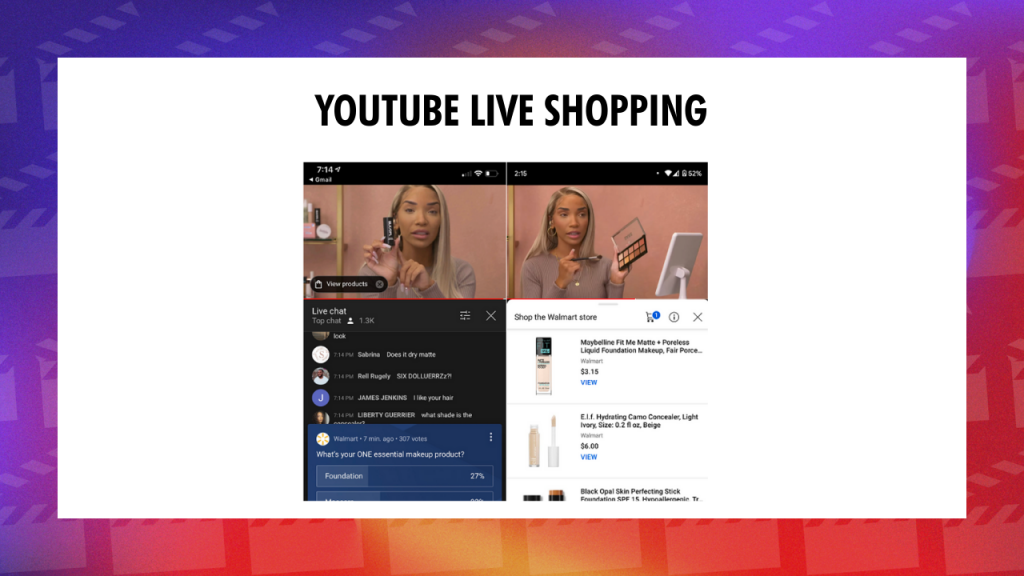
On some live shopping platforms, the product may be right by the host’s head. In other’s, it might be below the host. You just need to be mindful of that. With Ecamm Live, we can zoom and pan if we need to make any adjustments.
What is Your Audience’s Learning Style?
Here’s the thing. If you really want to connect with your audience, it’s all about understanding your audience’s learning style. What are their needs? How do they need to have the information in order to process what it is that you’re telling them?
Because let’s be honest, we live in a world full of different distractions. So how do you get people to stop, look, and listen to what it is that you have to say?
Let’s talk about learning styles. Warren Buffet once said that “one way to increase your worth is to hone in on your communication style.” And let’s be honest, not a lot of people spend time after, high school or even college, and invest in their communication skills.
We should all be paying attention to psychology of what moves people. One thing that I always found very fascinating was Dr. Bernice McCarthy. She was an educator, psychologist… all the things. And what she really noticed is that in the educational system back, I think it was like in the eighties or the seventies or so, she realized that people learn by asking specific questions.
People ask things like:
- Why do we need to learn this?
- What specifically do I need to know?
- What do I need to know for the test?
- How can I apply this?
- Can this impact my life?
- How can this change my routine?
- Or how can this make me feel better?
And then there’s the “what if” audience. These are the skeptics. They want to know what happens if they don’t do this? What are the consequences? What are they missing out on?
So when you factor all of that in, it really caters to the different audience learning styles that are out there. And this is really important for you to learn when you’re reviewing a client’s run of show, or if you’re developing a run of show for the client. Does your run of show have all of those components?
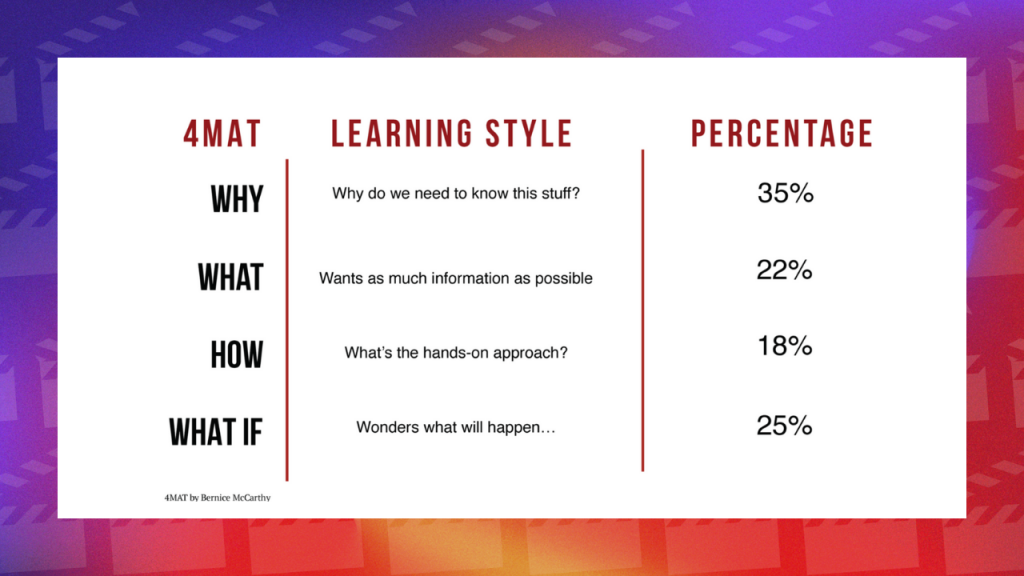
When we’re thinking about Showrunner: Secrets from the Set, the reason why you should tune into this episode is because the live shopping industry is a billion dollar market. And that’s a great opportunity for you to jump in there and take advantage of it.
Then there’s the “what audience.” They want to know as much information as possible. Listen, you can get started with live shopping easily just by tuning into the previous episodes, launching your Ecamm Live, and boom, you’re ready to go. I’m going to show you how.
So there’s your how audience, what’s the hands-on approach? Even in this training, in this masterclass, as I like to think of it, we’ve given you the how, we’ve given you the templates, I’ve shown you step-by-step.
You’re going to need to keep these audience learning styles in mind as you built out your live selling script.
So if you were to hone in on on this is why you should do this, why you should buy this and you only focus on the why, then you’re missing the what, how, and what if audiences. For example, if you’re on YouTube doing how-to tutorials and you’re saying “hey, I’m going to show you how to set up this Sony ZVE10 camera”, but you don’t explain the why, you may lose people. You’re not explaining why it’s important to them.
These are brain hacks.
Writing a Video Script for Live Selling

When I’m writing a video script, I take the audience’s learning styles and I add that into my intro, hooks, and teasers in the Video Script Maker.
What
Describe the video in one sentence.
Why
List three reasons to tune in.
How
How your video will impact your viewers
What if
Action to take if viewers can’t tune in live
So I’ll say okay, so the what, describe the video in one sentence, describe the live shopping event in one sentence, then you’re going to tell them why you’re going to give them three reasons on why they should tune in right now.
Good. Then you’re going to tell them how this product, how this episode, how this live shopping event is exclusive or how it’s going to impact their lives. Then you have, what if the action to take if viewers can’t tune in live or if viewers want to learn more. So let’s say for example, If I were going to say, let’s say this episode is about live selling script.
I’d say: “Hey everyone, I’m Stephanie Liu and welcome to Showrunner, live selling strategies to help you turn browsers into buyers. Let me tell you what you’re going to learn today. I’m going to tell you how you can ignite your ideas so that you could be brilliant in the boardroom and captivate your audience to earn more revenue. Because when you’re top of mind, you’re tip of tongue.
And so what you’re gonna learn is how to use the Video Script Maker. You’re going to learn brain hacks. You’re also going to learn how to use stories to sell. And how I’m going to do that is I’m going to show you the format process. I’m going to show you the Video Script Maker and all the different things and PS, by the way, if you don’t have time to stick until the very end that’s okay. Head on over to ecamm.tv/liveselling. That’s where you can get all the templates, the details, the show notes and all the different things so that way you can succeed with Ecamm. That’s a quick intro.
So when you focus on the what, why, how, and what if that’s going to be really easy for you as you’re filling in your run of show from a live selling perspective.
The Video Script Maker
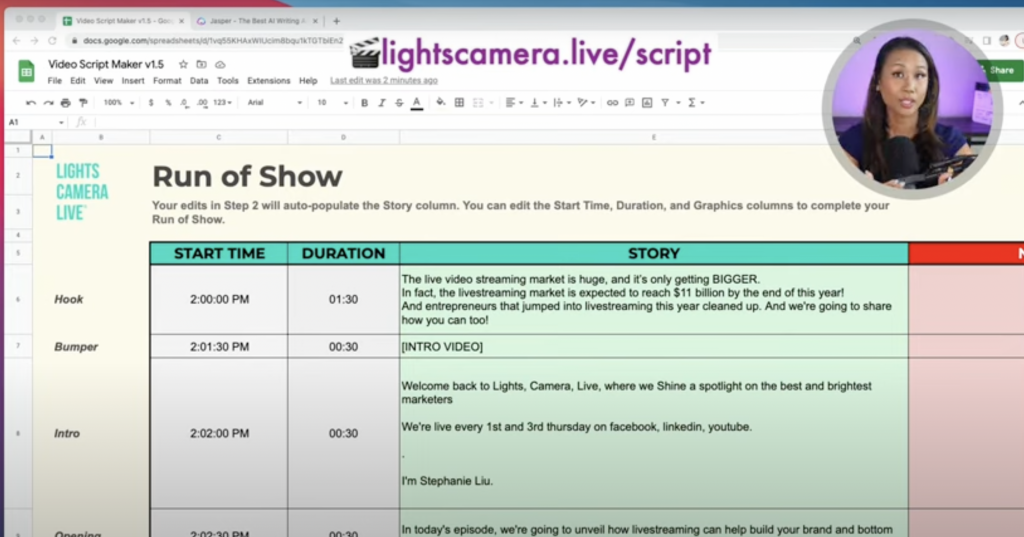
If you’re using the Video Script Maker, you can plug in everything into the tool and it’ll give your entire video script. You plug in the hook, bumper, intro, opening, teaser, audience, quote of the day, guest intro, etc.
If you have on your main question, what your setup is going to be, how to give a shout out to your sponsor, your bullet points, and then the tension, as far as like how you’re going to build up to that exact moment, your segment, the climax conclusion. Now the beauty behind this, as I told everyone last week is that every time you check and uncheck this box, you get a new prompt to help you as you write your run of show.
So you could say, have you ever felt stuck or clueless while live streaming? Have you ever felt irritated or frustrated and wish there was somebody to help you out? I heard you loud and clear, and that’s why we’re going to launch a new show all about Amazon Live shopping. That was just throwing that out there for you.
And so when you have this, you’re going to copy this, copy paste, special copy paste, special values into the draft. And then what happens next is you have your run of show.
Now, even though I’m telling you all of this, here’s the thing that I still want you to remember is as you’re developing that run of show, you still want to have the why, the what, the how, and the what if integrated into your run of show.
These are all things that is going to make you stand out from the sea of sameness as a live selling producer. And again, this is something else that you could even upsell a client on.
The Video Script Maker easily helps you develop what the bare bone basics of what it is that you need when you’re developing your run of show. Now, what we’re doing is relearning on top of it, the audience learning styles, the why, the what, the how, and the, what if.
When I generally do this with clients, I ask them to give me all of this information so I can plug it in and build a video script. That’s going to be information like the stats, the figures, the data, the testimonials, the stories, the products, the first-hand narratives… all that stuff.
Sometimes when I’m working with clients, they’ll develop like a script that they want their influencer or their presenter to read. It says something like “talk about how you discovered our brand” and a standard influencer would probably just be like, oh, I discovered your brand because of this, but there’s no structure around it. It doesn’t grab a viewer in, because they’re just answering a question.
They’re not taking the time, the energy, and the effort to really understand how to ignite their idea, how to motivate the masses. And that’s where we see all of the psychology that goes into this.
Crafting Successful Stories
Let’s talk about what goes into making a successful story that influencers or presenters can use to sell a product, overcome objections, and do all those things.
As a live selling producer, it’s important for us to understand that crafting successful stories helps our viewers understand our product or service differently. It’s going to help them fall madly and deeply in love with it. Regardless of your business model, we all sell some product or service.
And more importantly, we’re all here to ignite our ideas. How do we make this product a part of someone’s everyday life?
We want our viewers to support our projects and in order to be successful, it really lies in our ability to captivate on command. It’s our job to make them fall madly and deeply in love. So that way we can seal the deal. And oftentimes when I’m working with clients, they don’t spend a lot of time telling stories. That’s why video scripts and run of shows are so important.
So let’s talk about the art of telling stories. When we tell stories, the whole goal is to attract our audience. And not only that, but to help them remember us. Do you remember the product to connect the problem to the solution and insert our brand within it?
Also helping them understand the perceived benefit of acquiring this product or this service that we have to offer. So all of that, we have to awaken their interest, right? We have to awaken that and we have to use narratives. And the more that you can actually use first person narratives, testimonials, the better it’s going to be.
Storytelling really has so much potential for live shopping because it can help you captivate the audience’s attention and forge an honest relationship.
It also motivates the consumer to go from a present state, a present mindset, the problem, and get them to the desired outcome, which is the solution, which along that journey, shouldn’t be telling the story of your product. As a live selling producer, as the script writer, whatever you want to call it, you’re creating context around that product and you’re making it relevant, exciting a part of the consumer experience.
What I love about stories too, is that as you’re layering this into your run of show. You can use this technique at any point during a live shopping event, whether it’s explaining the product characteristics, managing expectations, answering questions, or overcoming objections. As I said at the very beginning, stories sell. Facts just tell.
Why do good stories work?
Stories are generally the primary means of communication for humans. And it’s been that way for the last 40,000 years. Stories were used to pass down traditions, culture, and lessons of survival. They stick in our memories and they stay there for a long time.
And why is that? It’s the fact that our brain stores indexes and recovers information when it’s told in a story format. One of the most intriguing studies that I read recently was from the Stanford Graduate School of Business. And one of the marketing professors, Jennifer Acre had said, research shows that our brains are not hardwired to understand logic or retain facts for a long time.
Our brains are actually wired to understand and retain stories.
A story is a journey that moves the listener, the viewer, the customer. And when the listener goes down that journey, they feel different. They shift their perspective. You start to open that door of possibilities, as I like to say. And that actually results in moments of persuasion to get them to do what it is that you want them to do.
The fact is that when we listened to a story, there’s this chemical reaction that actually happens in our brains that make us feel different emotions. And we could feel things like, oh, have you ever felt irritated, frustrated with OBS, right? Then maybe you were determined to learn something new.
And then you were curious about the possibilities. Notice how, when you’re telling stories, you’re shifting them in different mindsets. Now I know that you came here for the live selling script. I am elevating your experience right now on how you can connect with your consumers and create a neurological connection with them.
Now, traditionally when it comes to live shopping, or marketing in general, we traditionally try to sway consumers with studies, facts, figures, awards, arguments, and even claims. We think “oh, that’ll win them over. I’ll just show them all of these awards and stuff.”
But in actuality, there was an Edelman study that shows that the more that a brand just boasts about their accolades, it actually creates distrust because it becomes a limited one-sided relationship between the brand and the consumer.
I want you to think about that when you’re reviewing a client’s live selling script, are they just talking about themselves all the time? Or are they actually connecting with their audience with a personal narrative? Are they helping them?
If we appeal to feelings or emotions using stories, it’ll be so much easier to break down the barrier and create that neurological connection between the brand and the consumer.
Here’s the thing. You don’t need special skills or knowledge to be a good story seller. You just need to understand the building blocks of how stories work in order for you to create a positive effect on the buyer, the consumer.
Key Storytelling Components
Here are the key storytelling components that you want to have.
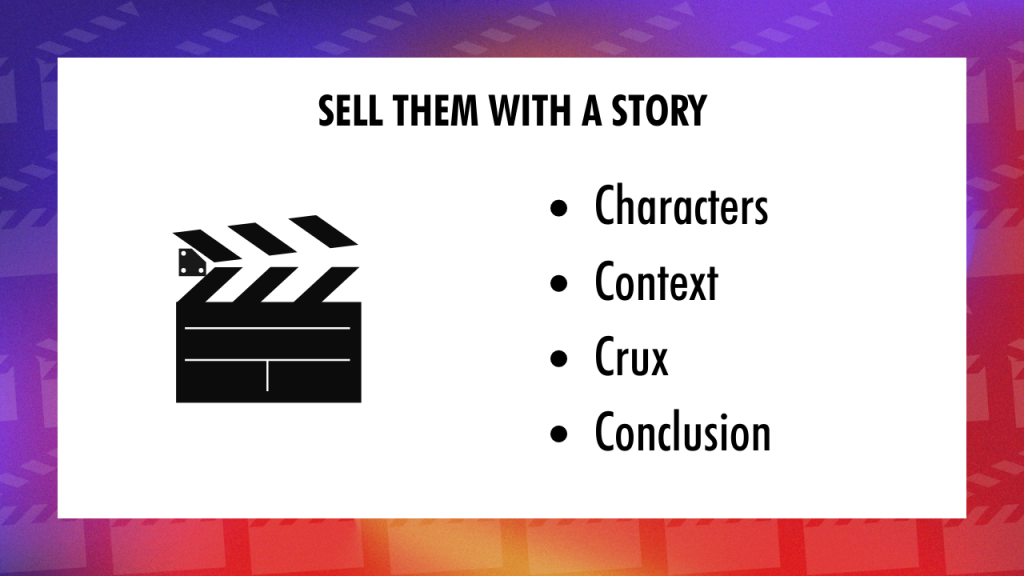
To sell them with a story, you need to know the characters, context, crux, and conclusion.
Who is the Main Character in Your Story?
It’s important to understand who’s the main character in your story. The consumer should be the hero or the protagonist in your story, right? The customer should be delighted, excited to be a part of the course of the events, because they want to feel as if, okay. That’s me. They feel as if it relates to them as if they’re connected to the narrative.
And when we also think about the characters that play a part in the story, you also want to know who’s the villain? And the villain isn’t necessarily a person. It could be the product, it could be the pain point. It could be what was, what used to work for them and is no longer working for them.
It’s the problem. So that’s what the villain is. Everyone is against.
You have to figure out who the characters are and what roles they play. Who’s the villain? What’s the main thing that everyone is trying to overcome?
And then you also want to put in the context, right? So now we’re moving onto the next piece of it. So again, you’re still looking at that Video Script Maker. You’re still layering. The why, the what, the how, and the what if. Now, we’re going into stories and who your characters are.
Let’s Talk Context
Every client, every consumer is different because they’re going to have different sets of circumstances that influence their decision making. And so as live selling producers, as marketers, we have to make a conscious effort to understand the context of where our consumers live and how we’re going to incorporate that into our narrative correctly.
How can we help them? We start building the context of where that product, that SaaS, that service, whatever it is. And we start building the context around that specific character.
When we’re looking at a video script, our client may just be like buy, but you’re saying, listen, if this is a 30 minute segment, if this is a one hour segment, however long we have to understand the context, the environment, right? The container that our customers live in. So that way we could give them the use case.
And when we do that, it’s going to help us develop and build the trust to capture their interest, by providing data, examples, and stories, and demos, and all the different things. Now, the next thing that’s happening is going to be the crux.
The Crux
Every story has a beginning, a crux, and then a resolution. The crux is the part of the story. And that’s where we need to reference the pain point. Have you ever struggled? If you could change one thing about your life, what would that be? This is where you start to you no longer have to feel that way.
You no longer have to struggle with that. And so when you have the cracks, you’re referencing the pain point or the need that the consumer is trying to overcome. And that could be the product or the service that satisfies that pain. That helps them overcome their pain point successfully.
We want to have different use case scenarios. Busy moms can use Ecamm if they want to sell their jewelry on Instagram or whatever, you know what I’m saying? Like you want to have different use cases to really help them.
Confused consumers don’t buy. We have to think of those different narratives.
We’ve Reached the Conclusion
Now let’s talk about the conclusion, right?
The conclusion is the ending. Once we’ve understood who the characters are, what are their pain points are, and how our product or our service can create new possibilities for them, that’s where we start telling them that this is the value that you’re going to get.
So for example, “hey everyone, the reason why that you should tune in today’s or actually this whole entire Showrunner series is because I’m going to show you how to turn browsers into buyers. And what you’re going to learn is how you can use stories to make your brand top of mind and tip of tongue and easily overcome objections. So that way you can generate more revenue, you can increase your bottom line, and build your brand awareness.”
That was the why, what, how, and what if.
When you have the characters, the context, the cracks, and the conclusion, you have the basic points to be a first rate storyteller and that’s what’s going to be really helpful. So again, as I said before, you’re layering all of this with the why, the what, the how, and the what if.
Know How to Tell a Good Story
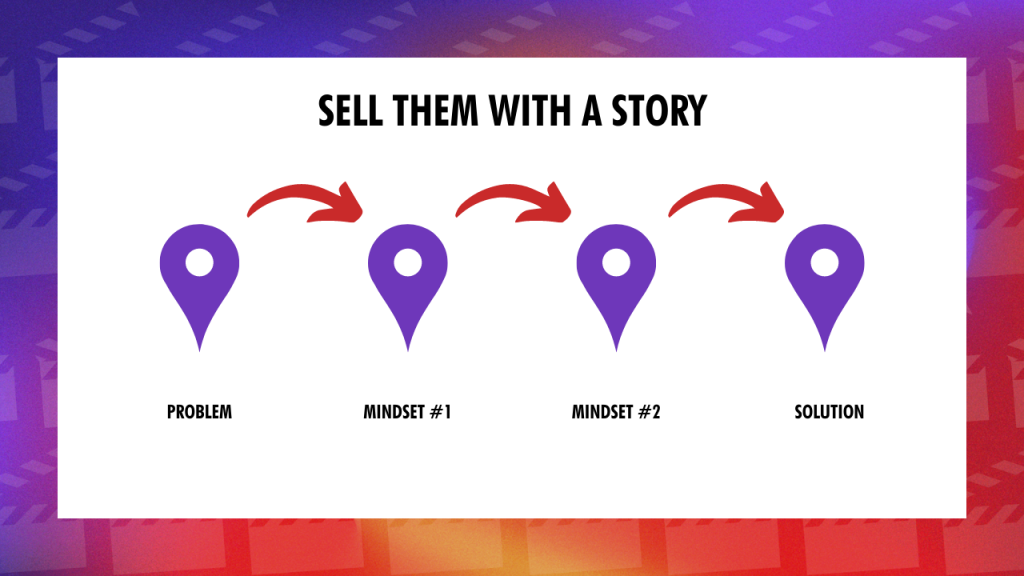
When you’re working with an influencer and you want them to tell stories, they have to know how to tell a freaking good story. Cause let me tell you, it was painful for me when I was sitting on a live shopping event and the next segment said, share how you know about this product, and our influencer went off on a tangent.
Part of telling a good story is camera coaching.
When you think about camera coaching, you may immediately think about the quality of the gear (the camera, the lights, the microphone), but what’s even more important is the quality of the storytelling and the host’s presence on camera. That’s something that needs to be trained and practiced. Remind your hosts that it’s about their audience. The focus is on the consumer and how the product or service is going to help them.
So you have the characters, the context, the crux, and the conclusion. But if you were to focus on the crux, right? How do you actually lay that out? Let me show you how I do this. When I am telling a story, I know that generally, when someone has a problem, it’s not easy for them to solve it because if it was easy for them to solve it, it wouldn’t be a problem.
Like for example, sometimes clients would be like, oh, I’m having trouble getting started with this project. If I just went to the client and said, okay we’ll just start. They’d be like no, it doesn’t work that way.
What I’m trying to say is that sometimes consumers have a problem and this is what we call like the present state in NLP. They have this problem. They’re feeling frustrated. They’re irritated, they’re overwhelmed, whatever that is. And the desired outcome is for them to be motivated, to feel like they’re taking action to finally solve it, but to get from here to there isn’t as fast as they want it to be.
So it doesn’t make sense for us to be like, just get started and do it. We have to give them a story. It’s like the training wheels that gets them closer and closer to their goal.
When people are frustrated or if they’re irritated, if they’re in a negative mental state of mind. You could tell because they start shifting. There are no unresourceful people. There are only unresourceful states of mind. And so if you were to do a live selling segment and you just focus on every single negative emotion, you’re not going to motivate anyone to buy. You have to get them into a productive mindset.
Your job is to take them from the negative mindset and help them to move towards another mindset. That other mindset can be curiosity, motivation, clarity, focus. And then what’s the next mindset after that? How do they finally get to the end game, the solution? That’s how your stories should be structured. Move the mindset, move forward, change the mindset, motivate the masses.

